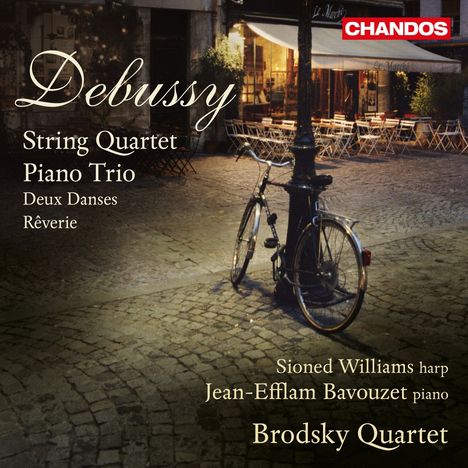Claude Debussy: Streichquartett g-moll op.10 auf CD
Streichquartett g-moll op.10
Herkömmliche CD, die mit allen CD-Playern und Computerlaufwerken, aber auch mit den meisten SACD- oder Multiplayern abspielbar ist.
Lassen Sie sich über unseren eCourier benachrichtigen, falls das Produkt bestellt werden kann.
+Klaviertrio G-Dur; 2 Danses für Harfe & Streichquintett; Reverie für Streichquartett
- Künstler:
- Jean-Efflam Bavouzet, Sioned Williams, Brodsky Quartet
- Label:
- Chandos
- Aufnahmejahr ca.:
- 2011
- UPC/EAN:
- 0095115171721
- Erscheinungstermin:
- 1.4.2012
Ähnliche Artikel
Die zweite CHANDOS-Produktion des Brodksy Quartets, das dieses Jahr sein 40jähriges Bestehen feiert, widmet sich Kammermusikwerken Claude Debussys, dessen 150. Geburtstag begangen wird. Im Klaviertrio stößt Jean-Efflam Bavouzet dazu, der für seine Debussy-Einspielung vom International Classical Music Award (ICMA) dieses Jahr zum Künstler des Jahres gekürt wurde. Aus drei guten Gründen eine Produktion zum Feiern!
Product Information
The Brodsky Quartet celebrates its fortieth anniversary this year. Formed in 1972, the Quartet quickly emerged at the forefront of the international chamber music scene. It has performed more than 2000 concerts and made more than fifty highly acclaimed recordings. Now exclusive Chandos artists, the Brodsky players are releasing their second album on Chandos with guest soloists Jean-Efflam Bavouzet and the harpist Sioned Williams.
The Trio for piano, violin, and cello is an early work, written before Debussy established his own very distinctive musical language heard in pieces such as La Mer. Another early piece, Rêverie, for piano, was written by the young, struggling composer at a time when he was trying to make a living in Paris. The easiest market to break into for a composer was the salon, where songs and not-too-taxing piano music were in demand. Rêverie was one of several charming and tuneful works that Debussy wrote for this scene.
In a somewhat different league, the String Quartet is considered a defining work in the history of chamber music. Sensual and impressionistic, it employs a cyclic structure that constituted a split from the rules of classical form and pointed the way forward. In the words of Pierre Boulez, Debussy freed chamber music from »rigid structure, frozen rhetoric, and rigid aesthetics«.
The Deux Danses, made up of the »Danse sacrée« and »Danse profane«, complete the disc. At the end of the nineteenth century, the Parisian instrument makers Pleyel invented a »chromatic harp« which dispensed with pedals and achieved the full chromatic compass from two rows of strings that slanted across one another. Debussy was approached to write two pieces intended for a final examination of the Pleyel model. »Danse sacrée« makes use of Church modes, while »Danse profane« is a kind of sarabande. The »competition« aspect of the pieces is highlighted by the fact that, after the opening introduction, the harpist has no more than six bars' rest. As it happened, the Pleyel model never caught on, and the works are now always performed on a pedal harp. (chandos. net)
Disk 1 von 1 (CD)
Streichquartett g-moll op. 10
-
1 1. Animé et très décidé - Un peu retenu - En serrant le mouvement - Premier mouvement - En animant - Toujours animé - ..
-
2 2. Assez vif et bien rythmé - Même mouvement
-
3 3. Andantino doucement expressif - Un peu plus vîte - Premier mouvement
-
4 4. Très modéré - En animant peu à peu - Très mouvementé et avec passion - Tempo rubato - Très animé - Très vif
Danse sacrée et danse profane (für Harfe und Streichorchester) (bearb. für Pedalharfe und Streichquartett)
-
5 Danse sacrée: Très modéré - Sans lenteur - En animant peu à peu - Retenu - Tempo 1 - Retenu -
-
6 Danse profane: Modéré - Animez - Tempo 1 - Animez - Retenu - A tempo - Animez - Retenu - A tempo - Très retenu - ...
Trio für Klavier, Violine und Violoncello G-Dur
-
7 1. Andantino con moto allegro - Allegro appassionato - Un poco rallentando - Tempo 1 - Allegro appassionato - Tempo 1
-
8 2. Scherzo: Intermezzo. Moderato con allegro - Un poco più lento - Tempo 1
-
9 3. Andante espressivo - Un poco più mosso - Tempo 1
-
10 4. Finale: Appassionato - Un poco ritenuto - (Tempo 1)
-
11 Rêverie (bearb. für Streichquartett von Paul Cassidy)










